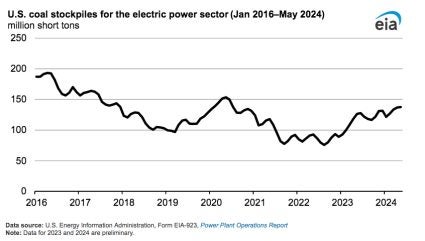
Coal stockpiles at US electric power plants totalled 138 million ‘short’ tons at the end of May, according to the Energy Information Administration, the most since the first half of 2020 when the effects of the COVID-19 pandemic reduced electricity demand and coal consumption.
In the USA, coal is typically consumed by power plants according to a curve that follows the seasonal pattern of electricity generation; most coal consumption occurs during the summer and winter. Because power plants consume more coal during the warm summer months, power plants typically begin increasing their coal stocks in the spring as plant operators prepare.
US coal power plants generally stockpile much more coal than they consume in a month, with more than 90% of coal-fired power plants currently having enough coal on hand to generate electricity for 60 days or more. EIA estimates days of burn as the number of days a sample of coal plants can generate electricity using their current stockpiles. Coal plant operators keep extra coal on hand because physical delivery constraints in the supply chain limit how quickly coal plants can increase their stockpiles.
As coal-fired electricity generation has declined in the United States over the last decade, coal plant stockpiles have also generally declined. Coal consumption by the electric power sector totalled 385 million tons in 2023, 43% less than in 2016. Coal stockpiles reached 131 million tons by the end of 2023, 19% less than stockpiles at the end of 2016.






